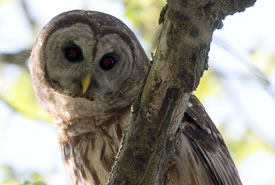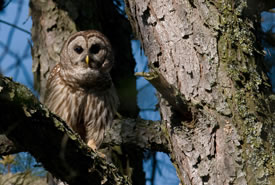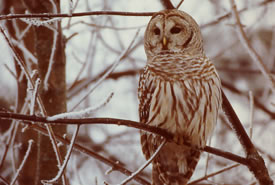Barred Owl

Barred Owl (Photo by Bill Hubick)
Barred owls are year-round residents of mixed, mature forests.
Where does this species live?
Barred owls nest in cavities of trees measuring six to 12 metres high. They are found exclusively in mature forests, which feature an abundance of prey and large mature trees with nesting cavities.
What does this species eat?
Barred owls prey on small mammals, such as:
- squirrels
- mice
- voles
- rabbits

Barred Owl (Photo by Bill Hubick)
They also feed on reptiles, amphibians and invertebrates.
These birds have been known to prey on birds up to the size of a grouse and will also catch fish and crayfish from streams.
Although they have been known to hunt in the day, barred owls typically begin hunting for food just after sunset and through the night. Once they have caught their prey, barred owls will store it in their nest or in the crook of a tree.

Barred Owl (Photo by George Pond)
Did you know?
Barred owl fossils more than 11,000 years old have been excavated from areas of Ontario, Florida and Tennessee.
The oldest barred owl on record was 24 years!
What does it sound like?
Click below to hear the distinctive call of the barred owl (courtesy of Bill Hubick.)
Supported by the Weston Family Foundation.




